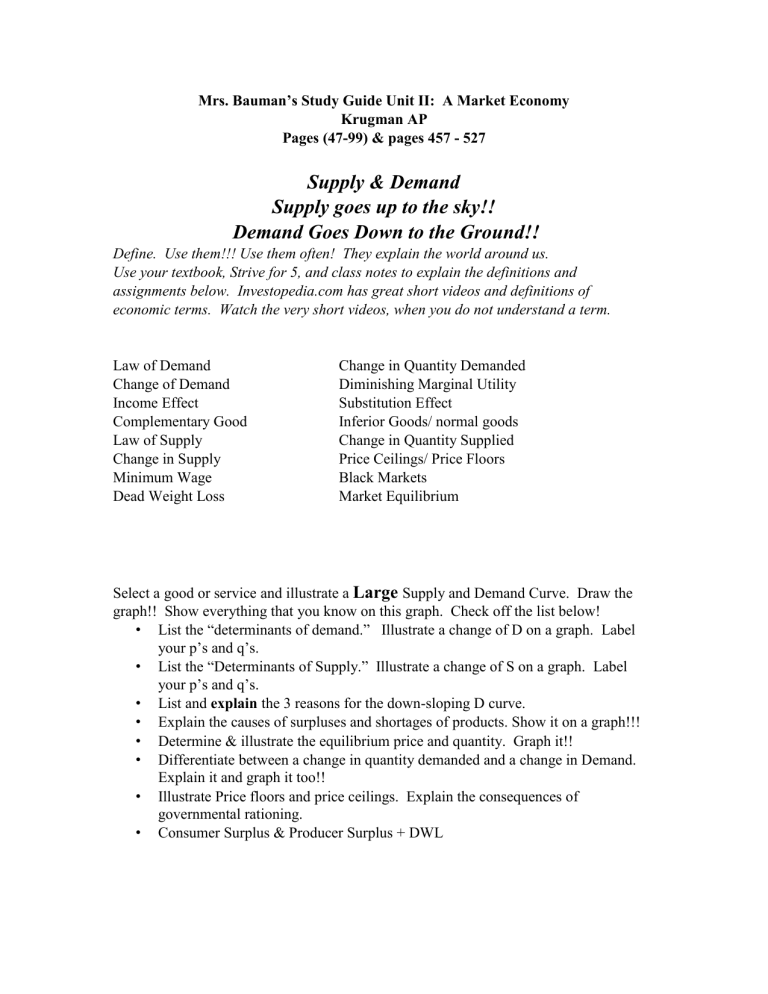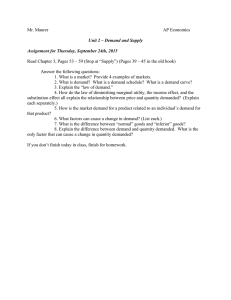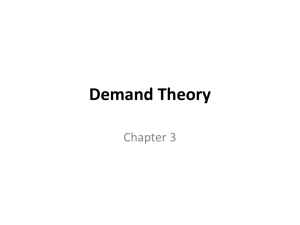
Mrs. Bauman’s Study Guide Unit II: A Market Economy Krugman AP Pages (47-99) & pages 457 - 527 Supply & Demand Supply goes up to the sky!! Demand Goes Down to the Ground!! Define. Use them!!! Use them often! They explain the world around us. Use your textbook, Strive for 5, and class notes to explain the definitions and assignments below. Investopedia.com has great short videos and definitions of economic terms. Watch the very short videos, when you do not understand a term. Law of Demand Change of Demand Income Effect Complementary Good Law of Supply Change in Supply Minimum Wage Dead Weight Loss Change in Quantity Demanded Diminishing Marginal Utility Substitution Effect Inferior Goods/ normal goods Change in Quantity Supplied Price Ceilings/ Price Floors Black Markets Market Equilibrium Select a good or service and illustrate a Large Supply and Demand Curve. Draw the graph!! Show everything that you know on this graph. Check off the list below! • List the “determinants of demand.” Illustrate a change of D on a graph. Label your p’s and q’s. • List the “Determinants of Supply.” Illustrate a change of S on a graph. Label your p’s and q’s. • List and explain the 3 reasons for the down-sloping D curve. • Explain the causes of surpluses and shortages of products. Show it on a graph!!! • Determine & illustrate the equilibrium price and quantity. Graph it!! • Differentiate between a change in quantity demanded and a change in Demand. Explain it and graph it too!! • Illustrate Price floors and price ceilings. Explain the consequences of governmental rationing. • Consumer Surplus & Producer Surplus + DWL Law of Demand- a higher price for something (all other things being equal) leads people to demand a smaller quantity of that good or service Change of Demand-the increase/decrease in the quantity demanded at any given point Income Effect-change in the quantity of a good demanded that results from a change in the overall purchasing of the consumer’s income due to a change in the price of that good Complementary Good- a good whose demand increases with the popularity of its complement, used in conjunction with another good often having little value without its complement Law of Supply-the higher the price offered, the more of any good or service producers are willing to sell Change in Supply-a shift of the supply curve (changes the quantity supplied at any given price) Minimum Wage-legal floor on the wage rate, which is the market price of labor Dead Weight Loss-cost to society created by market inefficiency when supply and demand are out of equilibrium Change in Quantity Demanded- a movement along a given demand curve resulting in a change of quantity demanded Diminishing Marginal Utility- as consumption increases, the marginal utility and satisfaction from each additional unit declines Substitution Effect-change in the quantity demanded as the good that has become cheaper is substituted for the good that has become relatively more expensive Inferior Goods/Normal Goods-demand drops when income is high/ demand rises when income is high Change in Quantity Supplied- a movement along a given supply curve caused by a change in supply price Price Ceilings/ Price Floors-max price sellers are allowed to charge/ min price buyers are required to buy Black Markets-place where goods or service are bought and sold illegally Market Equilibrium- where supply and demand curve intersect and are at a balance Determinants of Demand Taste Expectation of Future Income/Prices Number of Buyers Normal Goods (Income) Inferior Goods (Income) Substitutes (Price) Complements (Price) Determinants of Supply Productivity Price Resources Regulation Subsidies Suppliers # Tax Technology Trade Down-sloping D curve Substitution Effect-price of good increases, less consumption of good by individual Income Effect-reduction in consumer income decreases consumption of say housing Elasticity- ratio moving along demand curve, since price and quantity demanded always move in opposite directions, + % change in price leads to a - % change in the quantity demanded and vice versa. So the price elasticity of demand is mathematically a negative number. Surpluses caused by price floors aimed to help sellers, government rationing causes minimum wage Shortages caused by price ceilings aimed to help buyers, government rationing causes black markets Change in price changes Quantity demanded, Price DOES NOT change Demand.







